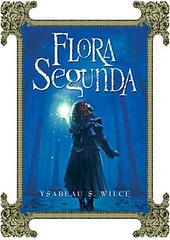An inquisitive reader asks:
How did you come up with the characters for your spoken magic? Are they taken from the alphabet of a real-life language I'm just not familiar with,or did you actually somehow digitally manufacture a font?
I know it's a real pain for typesetters to have to deal with weird characters or fonts (and alas that several of the letters I use, including the eth in Ha<eth>raa<eth>a and Landa<eth>on, are not standard to most fonts). I've been lucky so far in that the publishers I've dealt with have been very good sports about my wacky spellings and words.
Gramatica is supposed to be the language of those things which can not be spoken, in which Words can take concrete form. Therefore it's a non-alphabetic language. But how do you write down Words that can't be written down? Obviously, you have to use some sort of character set, but it was important to me that whatever these characters be, they not refer to aknown alphabet, nor they be easily read or pronounced.
In mss. form, I just use wing-dings to signify Gramatica Words, and I believe that is what The Magazine of Science Fiction and Fantasy used when they printed the two Hardhands stories. I know they had to manufacture an eth as it wasn't standard to the font they use--what they ended up with wasn't a perfect representation of the real letter, but it was close enough.
The credit for the super cool Gramatica fonts in Flora Segunda lies completely with Harcourt's book designers. Instead of just going with wing-dings, they decided to create their own non-alphabetic font, which they did to great effect. They also had a calligrapher design the wonderful title sequence. I was terribly pleased with how the Gramatica and the title calligraphy came out; Harcourt's desingers did a real whiz-bang job of coming up with lettering and symbols that are evocative and yet mysterious.
NB: In case you were wondering, in Califa eth is pronounced as a hard th. Therefore, Landa<eth>on is LandaTHon and Ha<eth>raa<eth>a is HaTHraTHa. In case you were wondering!
Tuesday, February 13, 2007
Subscribe to:
Post Comments (Atom)











6 comments:
what's a "hard th" -- is it like a "t"?
Thank you, Madama Wilce. And thank you, Harcourt designers for the extra-added magical touch. It's a huge improvement over the "d backspace hyphen" FSF had to use, which, until I subscribed to the Alta Califa, I was certain was a pernicious printing error and not deliberate. I hope you're all keeping track of the lingo, though, because next time we see Flora turning somebody into oatmeal we'll have our eyes tuned for any inconsistency. It's what we rabid fans do. So squiggle those T's and curlicue those I's!
Paul: It's probably not a proper linguistic term, but by "hard th" I meant an forcefully enunciated TH!
Erika: As far as keeping track of the lingo, Harcourt was actually pretty careful to make sure that there was continuity in their transcription. Maybe, a little more careful than I was...but then my devil is *always* in my details; I can't get him gone! Thanks for the heads up tho'; I surely shall be super careful in the future. There's nothing more annoying than finding errors AFTER the book has gone to print. Arg...
forcefully enunciated = letting the spittle fly?
Yeah, like that--spit cup at the ready!
THuffering THucotaTH!
Post a Comment